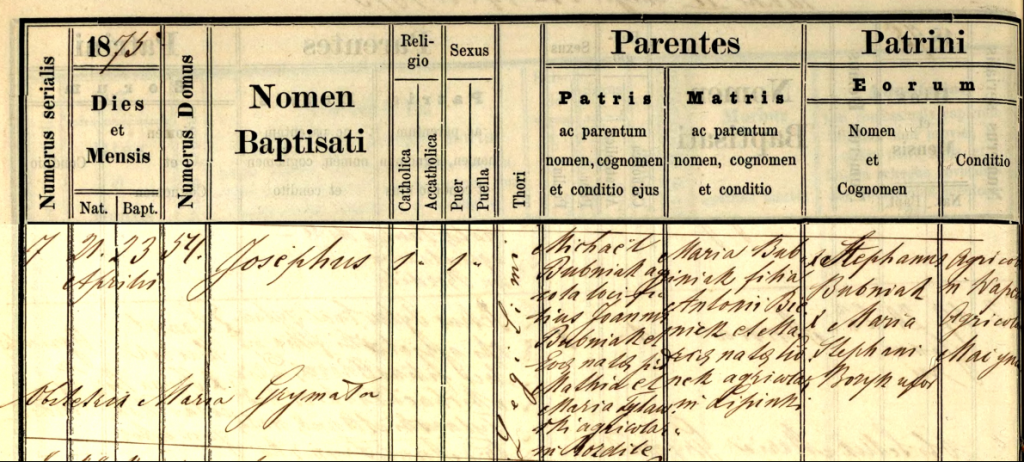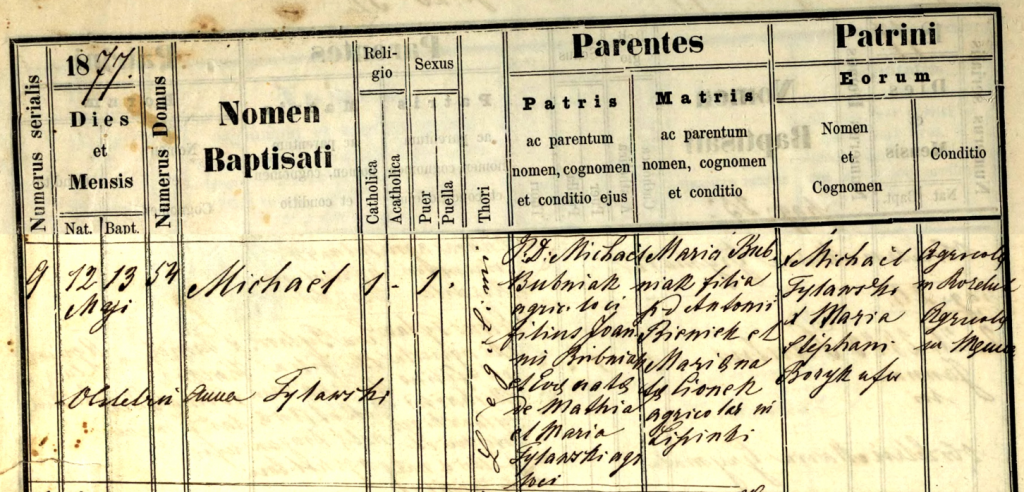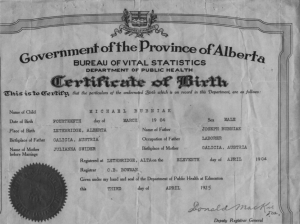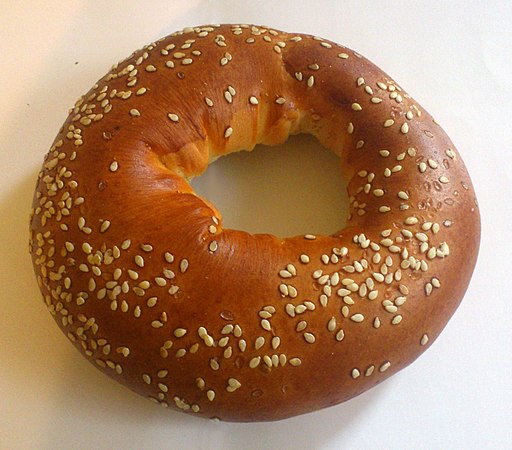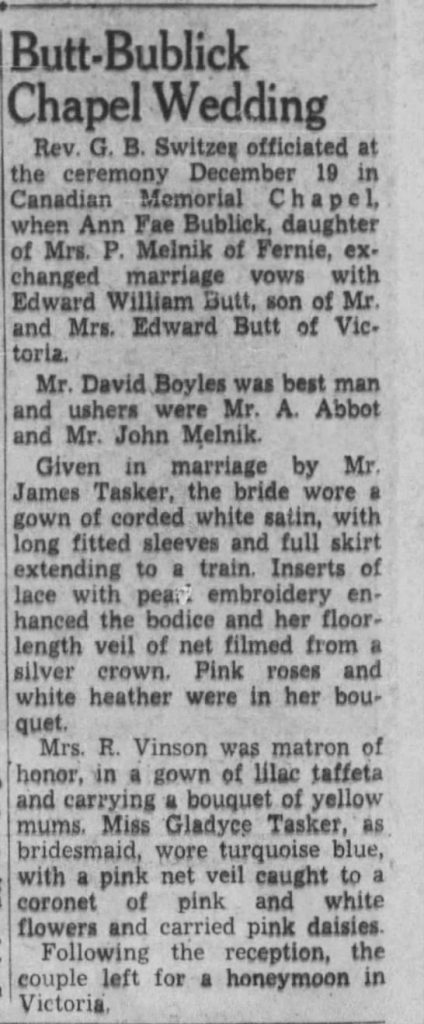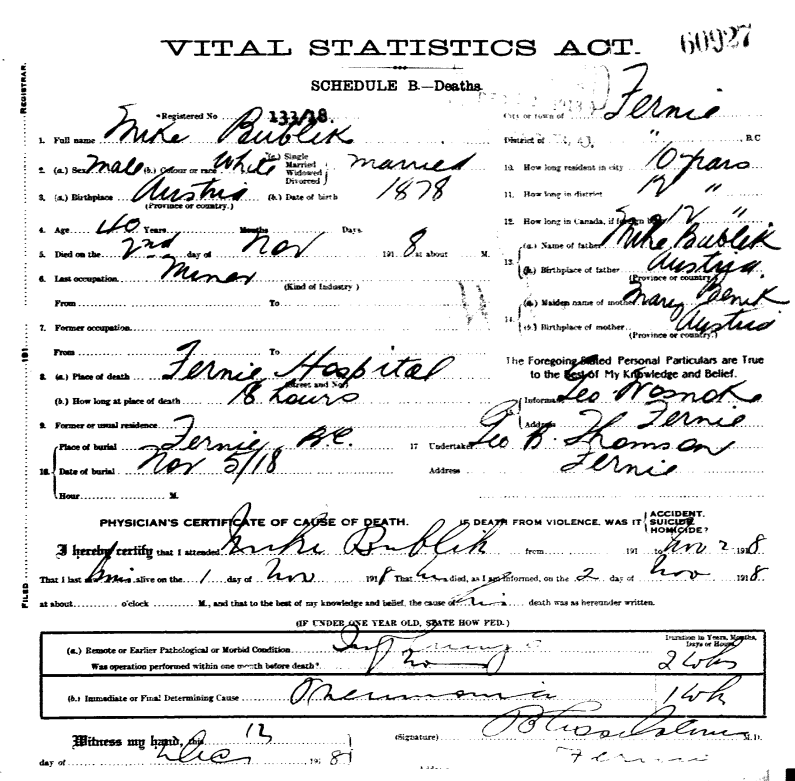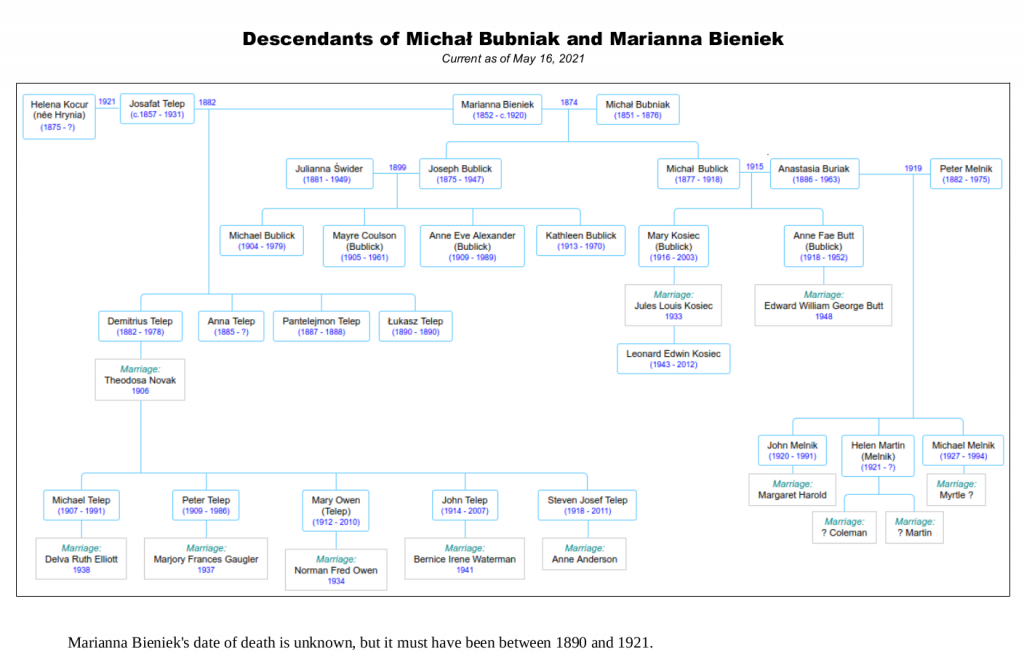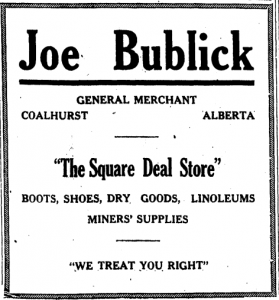
The Lethbridge Daily Herald, Dec. 17, 1920
My great-grandfather, Joe Bublick, ran a store in Coalhurst, Alberta, alongside his wife, Julia. They sold clothing, tools, household supplies, etc. to coal miners and their families.
At various times, Joe and Julia had more than one store under their purview, spread across the bustling coal mining towns north-west of Lethbridge– Diamond City, Commerce, and Coalhurst. The Coalhurst store was the last one they had before they retired in 1933, at which point they handed the store over to their daughter and her husband. Just in time for it to go bankrupt after the mine blew up in 1935 and put hundreds of people, including my grandparents, out of work at the height of the Great Depression… but that’s a whole ‘nother story. Joe and Julia, they retired to a peaceful little farm in Haney, British Columbia, and did fine.
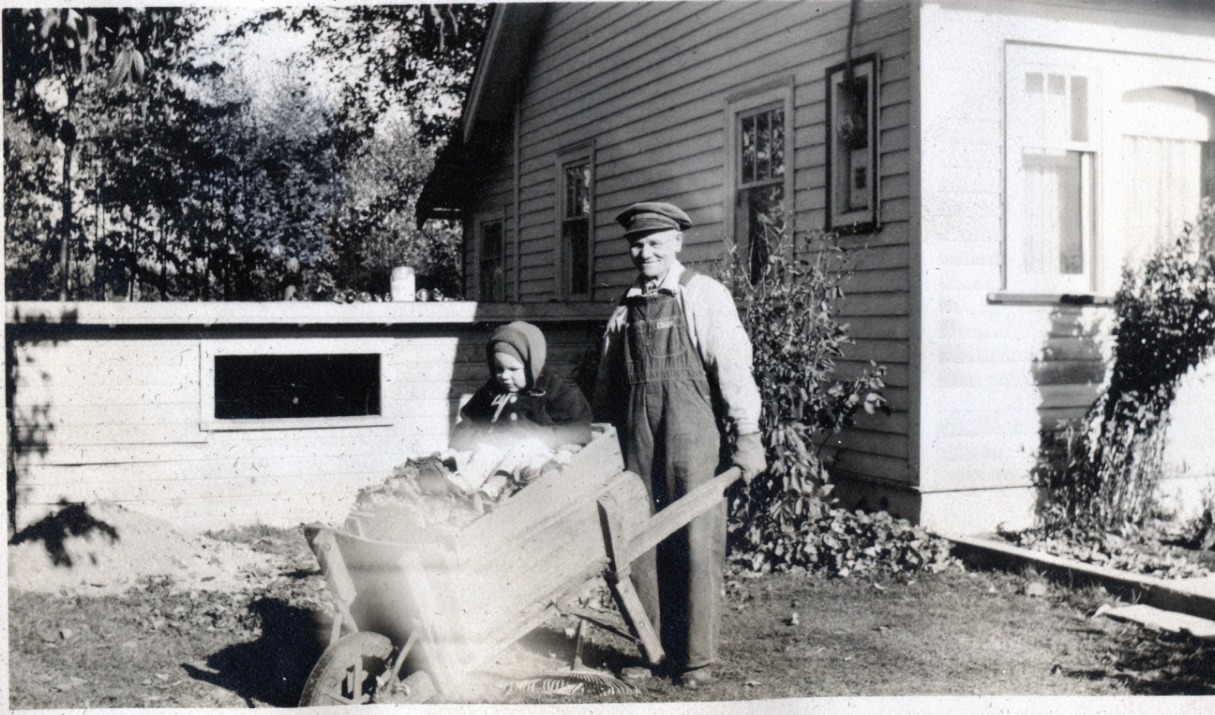
Joe Bublick gardening with his granddaughter Marian. Haney, B.C., 1946.
Bublick, as I mentioned in a previous blog post about Julia, was not Joe’s original surname. He was baptized Josephus Bubniak. Born in the village of Rozdziele in Austrian Galicia on April 21, 1875, his parents were Michael Bubniak and Marianna Bieniek, who came from old Greek Catholic serf families that had farmed the north slope of the Carpathian mountains near the Slovakian border for centuries. The records I got from the Polish National Archives tell me that Michael and Marianna had another son, Michael, born two years after Joe, but I had no idea what happened to him. Nobody in my family ever heard Joe talk about a brother, so I just assumed he must have died in infancy. It was all too common in those days.
Something else the records told me: Joe’s father died before little Michael was born, and their mother went on to marry a man named Josafat Telep. Josafat and Marianna had a son, Metro (Demetrius), and years later Joe and Metro would emigrate to North America and start new lives. Metro Telep went to Fernie, B.C., and worked in the coal mines there, and Joe, as we have seen, wound up in Coalhurst. The two half-brothers remained close friends for life, though, and I even met Metro once, shortly before he died in 1978, a very old man. He was known to our family as “Grandpa Telep”, but nobody knew for certain what his relationship to Joe was, until I tracked down those Polish birth, death, and marriage records.
Getting back to that name, Bublick…
When and why did Joe change his name from Bubniak to Bublick? This has always been one of the big riddles that drives my genealogical research.
The fanciful legend, that my dad remembers being told, is this. One day Joe said to his son, Mike, “Mike, nobody can pronounce our name. Think up something easier.” Mike thought about it, and he pulled the name “Bublick” out of thin air. Joe liked it, and sent Mike up the ladder with a can of paint to change the name of the store to “Bublick’s”. And that, supposedly, is how the name got changed.
This is impossible, of course.
Mike, Joe and Julia’s eldest child, was born in 1904, and his name was recorded as Bubniak. (However, all his life he went by Bublick, and this became a bit of a problem decades later when he went to apply for his Canada Pension).
So the family was still using Bubniak as of 1904. But on the 1906 Census, the family name is reported as Bublik; this is the earliest documented instance I have of the family using that name. That means that Mike would have been just a baby when he had to climb the ladder to change the store sign; a highly unlikely event. (Both Joe and his son Mike were, unsurprisingly, renowned for telling tall tales to the gullible).
Also untrue is the story that the name was made up; Bublick is a real name. One particularly famous holder of that name was Gedaliah Bublick, a journalist and Zionist activist who was instrumental in facilitating the wave of Jewish emigration out of Eastern Europe in the aftermath of terrible violence against Jews there in the early 20th century. The fact that he was a contemporary of Joe’s, and that they came from the same general part of the world, made me suspect that we may, in fact, have Jewish ancestry. I have subsequently uncovered absolutely no evidence to support that theory, but the possibility intrigued me for many years.
In addition to the Jewish connection, Bublik is also found as a surname throughout Ukrainian and Russian-speaking regions. However, in the records from the cluster of Carpatho-Rusyn villages connected to my ancestors, I have not found a trace of a single Bublik or Bublick. Plenty of Bubniaks, but no Bublicks.
A bublik is also a type of bread, similar to a bagel. It looks like this:
None of this enlightens me as to why Joe changed his name. But at least now I know approximately when he did it: 1904-1906.
Recently I made a breakthrough when I stumbled upon the following marriage announcement:
Butt-Bublick Chapel Wedding
Rev. G.B. Switzer officiated at the
ceremony December 19 in Canadian
Memorial Chapel, when Ann Fae Bublick, daughter of Mrs. P. Melnik of Fernie, exchanged marriage vows with Edward William Butt, son of Mr. and Mrs. Edward Butt of Victoria.
Mr. David Boyles was best man and ushers were Mr. A. Abbot and Mr. John Melnik.
Given in marriage by Mr. James Tasker, the bride wore a gown of corded white satin, with long fitted sleeves and full skirt extending to a train. Inserts of lace with pearl embroidery enhanced the bodice and her floor-length veil of net filmed from a silver crown. Pink roses and white heather were in her bouquet.
Mrs. R. Vinson was matron of honor, in a gown of lilac taffeta and carrying a bouquet of yellow mums.
Miss Gladyce Tasker, as bridesmaid, wore turquoise blue, with a pink net veil caught to a coronet of pink and white flowers and carried pink daisies.
Following the reception, the couple left for a honeymoon in Victoria.
I had no knowledge of any of these names. Ann Fae Bublick? Nope, never heard of her. But the fact that there were so few Bublicks in Western Canada at that time made me curious. And, the fact that she was from Fernie– the very town where Joe’s half-brother Metro Telep had settled— made me even more curious!
The mystery began unraveling quickly as I discovered clues in the newspapers and the genealogical archives of the Royal British Columbia Museum. The clincher was the death registration for a man named Mike Bublik, who died of influenza in Fernie in 1918. His parents are listed as Mike Bublik and Mary Benik, and his birth is given as 1878 in Austria. This is close enough to Michael Bubniak, son of Michael Bubniak and Marianna Bieniek, born 1877 in Austrian Galicia, that I am certain I have discovered Joe’s long lost brother!
Here, then, is the story of the Bublick/Bubniak/Telep boys, which I have reconstructed from the evidence.
Josephus (Jozef, Joe) Bubniak was born to Michael (Michał) Bubniak and Marianna (Maria) Bieniek in Rozdziele in 1875. Michael died when Joe was a baby, in November 1876. I’m not sure of his cause of death, but I suspect cholera; he was only 25 when he died. Six months after his death (May 12, 1877), his wife gave birth to another son, also named Michael. When Michael was 5 and Joe was 7, their mother married Josafat Telep, and they had a son, Demetrius (Dmytro, Metro), born November 1, 1882. The three boys (Joe, Mike, and Metro) grew up together, and they all must have departed for North America around 1900 or earlier, maybe together, maybe separately (I have yet to find authoritative immigration records for them).
Joe married a girl from his home village, Julianna Swedish (Świder), and they wound up in Lethbridge after a brief sojourn working in the coal mines of Pennsylvania. Joe became a merchant in Diamond City and Coalhurst, probably supplied by his brother-in-law Simon Swedish who had a thriving store in Lethbridge (here is a fascinating history of the Swedishes’ store). Mike and Metro went to Fernie and worked in the coal mines.
In about 1915 Mike married Anastasia (Nastya, Nettie) Buriak, who had recently immigrated from Husiatyn (Wilchovetz), a village from the part of Galicia that is now in Ukraine. They had two daughters: Mary (1916) and Anne Fae (1918).
In November of 1918, when Anne Fae was only 6 months old, Mike caught influenza and died, a victim of the 1918-1919 global Flu pandemic. The Vancouver newspapers mentioned Fernie as a major hotspot of the disease.
Nettie wasted no time; in March 1919 she married another miner, Peter Melnik, an immigrant from the Russian part of Ukraine. They had three more children in addition to Nettie’s two daughters: John (1920-1991), Helen (1921-?), and Michael (1927-1994). Nettie died in 1963 and is buried in the Fernie cemetery. Peter died in 1975 and is buried next to her.
Nettie’s first husband Mike Bublick is there too; he rests in a different section of the cemetery.
What happened to Mike and Nettie’s daughters? I am interested in them, because their descendants would be my blood kin. Mary got married in 1933 to Jules Kosiec, and Anne Fae, as we saw above, married Edward Butt in 1947. The interesting thing about their marriage registrations is that both brides are named Bublick (or Boublick, in Mary’s case), not Melnik. That tells me that Peter Melnik never formally adopted them.
Anne Fae died young. She had no children, and died in Vancouver of cancer in 1952.
Mary lived all her life in Fernie and died in 2003 at the age of 87. She outlived her husband Jules by 35 years. They had descendants who may still be living, meaning there are cousins out there I haven’t met yet.
It’s exciting to find a whole branch of the family tree you never suspected even existed. I still don’t know where the Bublick name came from, and now it’s lost to time, as nobody in the family bears it anymore. But there’s one thing I discovered from all this: Joe was not alone in his use of the name. His brother changed his name from Bubniak to Bublick, too.
Who knows, maybe the story about the ladder and the paint can has a kernel of truth– maybe it was not Joe’s son Mike who made the change, but his brother.
Here’s a tree sketching out the descendants of Marianna Bieniek and her two husbands:

